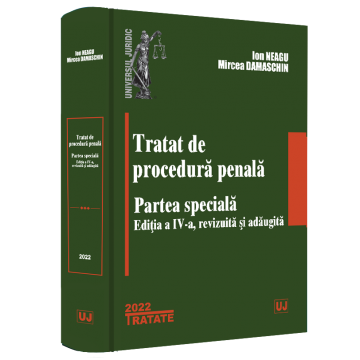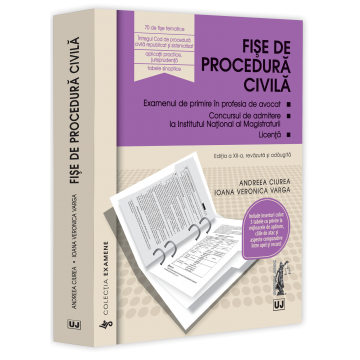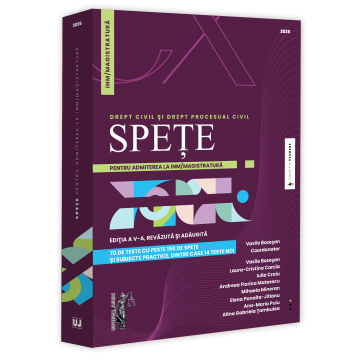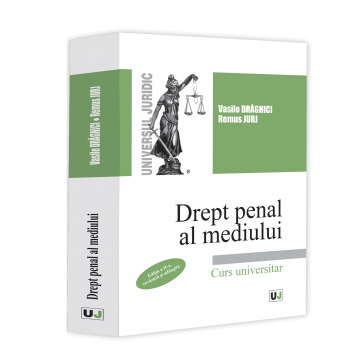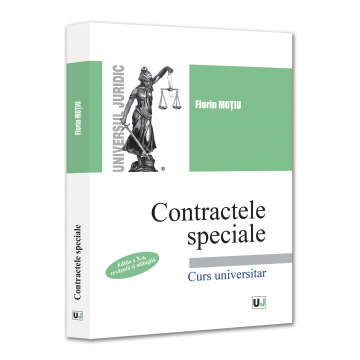ISBN: 978-606-591-218-2
Publisher year: 2011
Edition: I
Pages: 352
Publisher: Editura Universitară
Author: Cristina Anca Paiusescu, Oana Duta
- Description
- Download (1)
- Authors
- Content
- More details
- Reviews (0)
THE PLACE OF THE RIGHT OF COMMUNICATION IN THE FRAMEWORK
LEGAL SCIENCES
"Nam et ipsa scientia potestas est"
(For science itself is power)
Francis Bacon 1
Legal sciences. The concept of law. General presentation
Determining the object of legal sciences involves delimiting the scope of the researched phenomena, specifying the angle from which they are researched (because the same phenomena can be researched by two or more sciences, but from a completely different perspective and other methods), and establishing the degree ) of generalization with which the phenomena are studied.
The existence of law is closely linked to the existence of life in society, the law being considered since Roman antiquity a product of society, according to the Latin saying "ubi societas ibi jus".
Therefore, the science of law is a social science that studies the legal phenomenon in all its complexity, and "formulates the general principles based on which law structures an appropriate mechanism for influencing people's behavior, based on value requirements.
Legal sciences can be classified as follows:
Introduction to the study of law (General theory of state and law) which studies the general aspects of the state and law;
Historical legal sciences that study the state, law, politico-legal conceptions following their concrete evolution (history of state and law, history of legal doctrines, etc.);
Branch or special legal sciences, which study the legal norms and the corresponding legal relations on distinct branches and institutions of law (science of constitutional law, civil law, criminal law, administrative law, international law, labor law, commercial law , Community law, etc.);
Auxiliary legal sciences1 (auxiliary, participatory) which are closely related to legal sciences and which are used for a better knowledge of law, as well as for its improvement (forensics, forensic medicine, legal statistics, comparative law, legal sociology, logic law, legal psychology, legal anthropology, semiotics and legal semiology).
There is a close correlation between the legal sciences, they form a unitary whole, a system (the system of legal sciences).
The concept of law
The meanings of the notion of "law"
Etymologically, the term "right" has its origins in the Latin "directus" 2 (the adjective straight, direct, rectilinear), respectively "dirigo" (to direct, to order, to direct). In Latin, the corresponding term for the noun right was "jus" 3 (law, law, judgment), much closer to what law represents to us today.
We find the word law, in fact, in other languages, with the same meaning: droit (French), diritto (Italian), derecho (Spanish), recht (German), right (English), coming from the Latin directus (right, horizontal) - straight or straight line).
In the philosophical sense, the term has been used since antiquity to express the idea of fairness, justice, justice, having a predominantly ethical meaning (thus, according to Ulpianus1: "honest living" - the duty to live honestly, "suum cuique tribuere ”- to give everyone what they deserve,“ alterum nos laedere ”- not to harm another person).
In current speech, by "law", people mean, in particular, the meaning of "property right" (the right to vote, the right to leave, etc.), although this word is still associated, as an adjective, and in moral assessments (for example: right person, right action, right punishment), in a sense that exceeds the notion of objective or subjective law and is one of the ways of social reflection of human existence.
Legally, the right term has gained over time several meanings, of which the most important are:
- Law in the sense of the science of law (the totality of ideas, notions, concepts and principles that explain law and allow its study);
- Law is not only a science, but it is also a technique (of human coexistence) and an art 2 at the same time, ie a set of means used by state institutions that create or apply law, because legal rules impose obligations, organizes the general functioning of the state and society and offers the possibility of capitalizing on some interests, recognizing the capacity for individual participation in various social relations.
- Objective law - the totality of legal norms, ie the rules of social coexistence established in society. The law agrees and orders human needs and freedom. These rules of conduct impose obligations, establish and guarantee rights and freedoms, protect interests, recognize certain capacities, aptitudes of persons and possibilities of the state to protect these rights.
- Positive law
- that part of the objective right in force (active) at a given time. It represents the immediately and continuously applicable law, obligatory and susceptible to be carried out as needed by the public or coercive force of the state. The objective right versus the positive right is in a relationship from the whole to the part.
- Subjective law - the faculty, the prerogative of a subject of law to capitalize or to defend against third parties a certain interest, legally protected.
Subjective law belonging to the subjects of law enshrines the realization and application of law, bringing the right from the stage of "simple rule of law" to reality, inscribing, in a daily and individualized manner, the rule in society.
Objective law and subjective law represent two complementary hypostases of law. Subjective law is not and cannot exist in the absence of objective law.
The distinction between objective law and subjective rights is made in Romanian law using the formulas: norm agendi, respectively facultas agendi.
It should be noted that in addition to the legal term, the literature also uses the term "legal", which can be used both as an adjective (legal norm, legal relationship) and as a generic term for everything that means social relations regulated by law. .
Definition of law
The law can be defined as a set of norms established or recognized by the state, in order to regulate social relations according to the will of the state, whose observance is guaranteed by the coercive force of the state.
The concept of the legal system
The notion of the legal system.
If by law is meant a set of norms established or recognized by the state that aim to regulate existing social relations within a society, the concept of legal system is much more extensive including in addition to the legal norms in force and the legal norms that have existed in the past and are now repealed, as are the legal norms in the legislative draft phase and waiting to be adopted.
The legal system differs from one state to another depending on the combination of factors such as: geographical environment, popular traditions, religion, culture, historical development of the nation and the political environment in which it was formed.
Among the legal systems it is worth mentioning:
- the Anglo-Saxon system of law consisting mainly of: "common law" or "common law" consisting of customs and judgments and "statutory law" or "written law" consisting of laws passed over time by Parliament and applied in the United Kingdom of Great Britain and Northern Ireland, Australia, New Zealand, Canada and the United States of America;
- the system of Romanian-Germanic or continental law based on the supremacy of the written law and applied in continental Europe;
- religious legal systems based on "holy books" and the teachings of religious leaders such as the Muslim system existing in some Arab states and based on the Qur'an and the teachings of the Prophet Muhammad;
- traditional legal systems based on the preservation of traditions and the protection of the development of family or work relations by keeping them unchanged, systems that are found, especially, in China, India (where there is still a caste organization) or Japan;
- socialist, centralized legal systems, based on the supremacy of socialist teachings and the decisions of the communist party (Cuba, Vietnam, China and North Korea).
The structure of the legal system
The basis of any legal system is the legal norm that regulates the most important social relations existing within a state.
The legal institution consists of a set of legal norms that regulate a unitary group of social relations having the same object.
The branch of law consists of a set of rules and legal institutions that regulate social relations that arise in a field of social life with the same object (such as family relations - which form the object of regulation of the branch of family law or relations of labor - which forms the object of regulation of the branch of labor law).
The branch of law includes a larger grouping of legal norms, as well as several legal institutions linked together by their common object, by common principles and by the unity of method.
The division of law
Division of law (modalities)
Although it is considered that the existing law in a state forms a unitary system of law, the legal doctrine, starting with the Romanian one, has divided the law into several categories such as:
- the internal law formed by the legal norms that refer only to the population on the territory of the state and the external law formed by the legal norms that regulate the relations between the states;
- the determining right that establishes or determines the conduct of the persons and the sanctioning right that shows chas are the sanctions for violating this conduct1;
- the public law that has as object of regulation the defense and protection of the social relations regarding the state and the legal relations that arise between it and the other subjects of law and the private law that defends and protects the interests of each person, regulating the legal relations between them.
The division of law into public law and private law
The division of law into public law and private law is the oldest and, at the same time, the most important division of law, being made, for the first time, by Ulpian in his work "Digest" based on the criterion of "utility" or response to the question: "Who uses law?" If the answer was: "State" then we are in front of a norm of public law, and if the answer was: "People" then we are in front of a norm of private law.
The doctrine took over the division proposed by Ulpian, completing it with two new criteria:
- a first criterion is that of the object of legal regulation or social relations protected by legal norms, which establishes that when these social relations concern the interest of the state - we are in front of public law norms, and when they concern the interest of each of us - we are facing rules of private law;
- the second criterion is that of the method of regulation or of the position of the parties within the legal relations, which considers that when there is subordination of one of the parties to the other party, which is always the state - we are in front of public law, and when there is legal equality between the parties, we are faced with norms of private law.
-
Dreptul comunicarii. Consideratii teoretice si legislatie relevanta
Download
Oana Duta is lecturer in the Faculty of Tourism Management and Commercial , Dimitrie Cantemir University, Bucharest, for courses Commercial and General Theory of Law.
Works published:
- EU Accession Treaty - the requirements of European integration, Editura Universitară, 2010
- Accounting in trade. University course in collaboration with Prof. Mihaela Dumitrana and Lect.univ.drd. Luminita Jalba, Universe Publishing House, Bucharest 2005;
- Accounting companies in trade and tourism, university course in collaboration with Prof. Mihaela Dumitrana and Lect.univ.drd. Luminita Jalba; Cantemir Christian University Press, Bucharest 2004;
- The lease, modern technical contracting (International Scientific Session 330 years after his birth Cantemir, leading figure of European culture, Bucharest 2003)
- State the main subject of public international law, in collaboration with Cons.jur. Daniel Duta (Annals Cantemir Christian University 2005 2006)
- Implementation of the equivalent of civil obligations in collaboration with Cons.jur. Daniel Duta (Annals Cantemir Christian University 2004-2005)
- Court of Justice in collaboration with Cons.jur. Daniel Duta (Annals Cantemir Christian University 2004-2005)
- Legal nature of unilateral promise of sale in conjunction with Cons.jur. Daniel Duta (International Scientific Session Remembrance Stefan cel Mare 500 years Cantemir organized Christian University);
- Accounting between legal theory and economic theory. Substance over form on the economic and juridical in collaboration with Lect.univ.drd. Luminita Jalba (scientific session organized by Christian University in Constanta Cantemir 2004)
Cristina Anca Paiusescu
Chapter 1
GENERAL NOTIONS ABOUT LAW AND LEGISLATION.
THE PLACE OF THE RIGHT TO COMMUNICATE IN THE LEGAL SCIENCES / 15
Legal sciences. The concept of law. General presentation / 15
Division of law / 19
The relationship between law, morality and deontology in the field of public communication / 34
Ethics and morals / 34
Deontology / 38
The place of the Right of communication within the legal sciences / 43
The right to social communication. Object. Notion. Methods / 45
Principles of the law of communication / 46
Chapter 2
PRINCIPLES OF THE LAW OF SOCIAL COMMUNICATION / 48
The principle of legality / 52
The principle of equality in rights / 53
The principle of good faith / 55
The principle of truth / 56
The principle of correct information of the public opinion / 58
The principle of freedom of expression / 59
The general principle of individual freedom / 61
The principle of the presumption of innocence / 63
The principle of responsibility and liability / 66
The principle of impartiality and objectivity / 67
The principle of professional secrecy / 68
The principle of humanism / 70
The principle of free access to information / 70
The principle of copyright or authorized communication / 71
Chapter 3
THE CONCEPT OF HUMAN FREEDOMS AND CITIZENS 'RIGHTS. FREEDOM OF EXPRESSION AND FREEDOM OF THE PRESS. GUARANTEES OF PRESS FREEDOM. / 74
Human rights, public liberties and civil rights / 74
Legal consecration of human rights and their universalization / 75
Classification of fundamental rights and freedoms / 79
Freedoms of communication (and of expression): freedom of conscience, freedom of expression, right to information, right to privacy, family and private life / 80
Freedom of conscience / 80
Freedom of expression / 82
The right to information / 88
The right to intimate, family and private life / 92
Freedom of expression and freedom of the press / 96
Rules on freedom of speech and freedom of the press / 96
Legislation of the written press in Romania / 96
The distinction between freedom of expression and freedom of the press / 99
The importance of press freedom / 100
The object of freedom of expression through the press / 101
Principles of communication in "news" and in "opinions" / 102
Holders of freedom of expression through the press / 103
Guarantees of press freedom / 106
Chapter 4
The rights and obligations of persons in the field of social communication. Limits of freedom of expression
and communication / 110
Domestic and international legal norms regarding the main aspects of the communication / 110
Freedom of expression / 110
Communication rights / 111
Freedom of expression / 111
The right to information / 112
Legal guarantees regarding access to information of public interest / 116
Category of secret information / 119
Special provisions regarding the access of the mass media to the information of public interest / 122
Sanctions / 123
Freedom of conscience / 124
Limits of freedom of expression and communication / 126
Respect for intimate, family and private life / 126
Chapter 5
Public communication and legal protection of personal data. / 133
Law no. 677/2001 for the protection of individuals with regard to the processing of personal data and the free movement of such data / 133
Definitions / 134
Legal framework / 135
Duties of the National Supervisory Authority for Personal Data Processing of the supervisory authority / 135
The scope of application of Law no. 677/2001 / 136
Legitimacy of personal data processing / 138
Protection of personal data in the National Information System for Alerts. Romania 's participation in the Schengen Information System / 139
Obligations of personal data controllers / 140
The rights of the data subject in the context of personal data processing / 141
Rights of foreign citizens regarding the protection of personal data / 146
.Complaints addressed directly to the National Authority for the Supervision of Personal Data Processing (ANSPDCP) / 146
Chapter 6
THE JOURNALIST (MEDIA AGENT) - THE MAIN ELEMENT OF THE LEGAL REGULATION OF THE RIGHT OF COMMUNICATION.
DEONTOLOGICAL NORMS IN THE FIELD OF MASS-MEDIA
LEGAL REGIME OF THE PRESS / 152
Communication Law and Media Law / 152
Media law and the political system / 152
Articulations and content of the right of communication in the field of mass media / / 155
The status of radio and television / 157
Considerations on the importance of access to information / 160
Regulations regarding the accreditation of journalists. Unconstitutionality of the provisions regarding the refusal or withdrawal of accreditation / 162
Procedures and sanctions provided by law in case of violation of the provisions regarding access to information of public interest / 163
The journalist (Media Agent) - The main element of the legal regulation of the communication right / 166
Professional status of journalists / 168
Defining the journalist / 168
Employed journalists and collaborating journalists / 169
Termination of the employment contract. Consciousness clause / 170
Deontological norms of the journalistic profession / 172
European regulation / 172
Internal legal regulation / 176
“Yellow journalism” / 180
Chapter 7
The legal regime of the press in Romania / 181
Legal regulations in the field of press in Romania / 181
Statutes and deontological codes of journalists / 187
The rights and obligations of journalists / 188
The right to be informed / 188
The right of access to information sources / 189
Respect for privacy / 189
The right of the individual to his own image / 191
Protection of young people and other categories of people / 193
The right to criticism / 196
The right to reply and rectification / 199
Legal regulation of the right to reply in Romania / 202
The right to protection of sources / 211
Chapter 8
The right to reply - the right to reply in the written press. THE RIGHT TO REPLY AND CORRECTION IN
AUDIOVISUAL / 213
The right to reply - the right to reply in the written press / 216
The right to reply and rectification in audiovisual / 220
Procedure for exercising the right to reply / rectification / 223
Chapter 9
THE RELATIONSHIP OF THE PRESS WITH JUSTICE. LEGAL RESPONSIBILITY OF JOURNALISTS / 226
Legal liability of journalists - object of legislative controversies / 226
Disciplinary liability of the journalist / 227
The patrimonial responsibility of the journalist / 229
The patrimonial responsibility of the journalist towards the employer / 229
The patrimonial responsibility of the journalist towards third parties / 229
Contraventional and criminal liability / 230
Criminal liability of journalists / 232
Press crimes / 233
Particularities of the press crime / 234
Press crimes in the legislation in force / 235
Presentation of press crimes / 236
Crimes (crimes) against dignity: slander and insult / 236
Offenses against authority / 250
Crimes (offenses) against state security / 253
Crimes that affect relations regarding social coexistence / 255
Deeds that have a criminal character only in time of war / 258
Civil liability for acts that harm the dignity of the person / 258
Civil liability and criminal liability. The cumulation between the two forms of liability / 259
Categories of damages that may result from human rights violations / 260
Legal basis of civil liability for moral and material damages in case of violations of personality rights through the media (art. 998-999 Civil Code) / 261
Legal liability established by Decree 31/1954 regarding natural and legal persons / 261
Chapter 10
Press in election campaigns. The right to the antenna. Electoral advertising / 263
Guaranteeing access to public radio and television services of electoral competitors / 263
Conditions regarding the access of the electoral competitors to the public radio and television services / 266
Rules regarding the exercise of the right to antenna in the electoral campaign / 270
The right to reply and the right to rectification / 272
Secondary legislation. Decisions / Recommendations of the National Audiovisual Council / 273
Chapter 11
Communication through advertising. LAW AND LEGISLATION IN THE ADVERTISING FIELD / 278
Public Relations Agencies, Department of Advertising, Advertising and Journalism: what are the boundaries / 278
Advertising: “advertising” or “publicity” / 279
Advertising (advertising) / 279
Publicity / 280
Advertising functions. / 280
The field of legal regulation of advertising / 282
General framework of advertising restrictions / 283
Advertising and promotion on the Internet / 285
Forms of online advertising / 285
Advertising and promotion / 285
Email advertising / 285
Misleading advertising / 286
Comparative advertising / 287
Ecological advertising / 288
Sensitive fields of advertising / 289
Advertising for minors / 289
Tobacco advertising / 290
Advertising for medicines / 290
Advertising control / 290
Control bodies / 290
The rules of audiovisual advertising / 291
Rules / 292
Interruption / 292
Conditions / 293
Advertising and teleshopping conditions for alcoholic beverages / 293
Harmful contents / 294
Procedure in case of notification of a violation of the rules regarding advertising / 294
Speta / 295
Chapter 12
Freedom of expression on the Internet / 296
Internet - source of communication / 296
International documents on freedom of expression via the Internet / 297
The need for legal regulation in the field of internet / 299
Legal regulation of freedom of expression on the Internet / 300
Factors contributing to the encouragement of freedom of expression via the Internet: / 300
Internet and protection of Internet content receivers / 302
Aself-regulation / 303
User age verification systems / 305
Retention and preservation of traffic data by Internet service providers ("Data Retention") / 305
Legal regulation of internet content in the European Union and in various countries of the world / 306
Regulation of internet contents in Romania / 307
Internet and copyright. Brief considerations regarding the exercise of copyright on the internet / 308
The case of Sony Betamax / 308
World Intellectual Property Organization Treaty / 309
Law no. 8/1996 on copyright and related rights / 310
Chapter 13
Freedom of expression and the law of pornography / 312
Legal regulation / 312
Legal definitions / 312
Prevention and control of pornographic activities / 313
Offenses and contraventions / 314
Internet Pornography / 315
Adult Internet Pornography / 315
Child pornography on the Internet / 318
Chapter 14
Communication in public institutions / 320
Concept and ways of communication in and from public institutions / / 320
Communication barriers / 322
Interpersonal communication in public administration / 323
External communication of the public administration / 324
Communication between public institution and citizens / 325
Communication between civil servant and citizen / 327
Development of the Public Administration Information System / 328
The general structure of the informatics and informational system of the public administration / 329
The normative framework of the information system of the public administration / 330
Factors influencing the pace of transition to the Information Society / 330
14.6. General legal aspects regarding the administrative contentious / 333
The concept of “administrative litigation” / 333
Characteristics of administrative litigation: / 333
Cases (reasons) that can lead to litigation (lawsuits) between public authorities and citizens: / 334
The procedural phases of the administrative contentious / 335
Judgment phase (administrative appeal phase) / 335
Chapter 15
National Audiovisual Council (CNA) / 337
Regulations, organization and functioning of CNA / 337
Duties regarding the granting of audiovisual licenses and retransmission authorizations / / 342
Regulatory attributions in the audiovisual field / 344
Attributions regarding the control of the observance of the obligations belonging to the holders of the broadcasting licenses and of the technical conditions from the authorization decision, the ascertainment of the contraventions and the application of the sanctions in the audiovisual field / 346
THE PLACE OF THE RIGHT OF COMMUNICATION IN THE FRAMEWORK
LEGAL SCIENCES
"Nam et ipsa scientia potestas est"
(For science itself is power)
Francis Bacon 1
Legal sciences. The concept of law. General presentation
Determining the object of legal sciences involves delimiting the scope of the researched phenomena, specifying the angle from which they are researched (because the same phenomena can be researched by two or more sciences, but from a completely different perspective and other methods), and establishing the degree ) of generalization with which the phenomena are studied.
The existence of law is closely linked to the existence of life in society, the law being considered since Roman antiquity a product of society, according to the Latin saying "ubi societas ibi jus".
Therefore, the science of law is a social science that studies the legal phenomenon in all its complexity, and "formulates the general principles based on which law structures an appropriate mechanism for influencing people's behavior, based on value requirements.
Legal sciences can be classified as follows:
Introduction to the study of law (General theory of state and law) which studies the general aspects of the state and law;
Historical legal sciences that study the state, law, politico-legal conceptions following their concrete evolution (history of state and law, history of legal doctrines, etc.);
Branch or special legal sciences, which study the legal norms and the corresponding legal relations on distinct branches and institutions of law (science of constitutional law, civil law, criminal law, administrative law, international law, labor law, commercial law , Community law, etc.);
Auxiliary legal sciences1 (auxiliary, participatory) which are closely related to legal sciences and which are used for a better knowledge of law, as well as for its improvement (forensics, forensic medicine, legal statistics, comparative law, legal sociology, logic law, legal psychology, legal anthropology, semiotics and legal semiology).
There is a close correlation between the legal sciences, they form a unitary whole, a system (the system of legal sciences).
The concept of law
The meanings of the notion of "law"
Etymologically, the term "right" has its origins in the Latin "directus" 2 (the adjective straight, direct, rectilinear), respectively "dirigo" (to direct, to order, to direct). In Latin, the corresponding term for the noun right was "jus" 3 (law, law, judgment), much closer to what law represents to us today.
We find the word law, in fact, in other languages, with the same meaning: droit (French), diritto (Italian), derecho (Spanish), recht (German), right (English), coming from the Latin directus (right, horizontal) - straight or straight line).
In the philosophical sense, the term has been used since antiquity to express the idea of fairness, justice, justice, having a predominantly ethical meaning (thus, according to Ulpianus1: "honest living" - the duty to live honestly, "suum cuique tribuere ”- to give everyone what they deserve,“ alterum nos laedere ”- not to harm another person).
In current speech, by "law", people mean, in particular, the meaning of "property right" (the right to vote, the right to leave, etc.), although this word is still associated, as an adjective, and in moral assessments (for example: right person, right action, right punishment), in a sense that exceeds the notion of objective or subjective law and is one of the ways of social reflection of human existence.
Legally, the right term has gained over time several meanings, of which the most important are:
- Law in the sense of the science of law (the totality of ideas, notions, concepts and principles that explain law and allow its study);
- Law is not only a science, but it is also a technique (of human coexistence) and an art 2 at the same time, ie a set of means used by state institutions that create or apply law, because legal rules impose obligations, organizes the general functioning of the state and society and offers the possibility of capitalizing on some interests, recognizing the capacity for individual participation in various social relations.
- Objective law - the totality of legal norms, ie the rules of social coexistence established in society. The law agrees and orders human needs and freedom. These rules of conduct impose obligations, establish and guarantee rights and freedoms, protect interests, recognize certain capacities, aptitudes of persons and possibilities of the state to protect these rights.
- Positive law
- that part of the objective right in force (active) at a given time. It represents the immediately and continuously applicable law, obligatory and susceptible to be carried out as needed by the public or coercive force of the state. The objective right versus the positive right is in a relationship from the whole to the part.
- Subjective law - the faculty, the prerogative of a subject of law to capitalize or to defend against third parties a certain interest, legally protected.
Subjective law belonging to the subjects of law enshrines the realization and application of law, bringing the right from the stage of "simple rule of law" to reality, inscribing, in a daily and individualized manner, the rule in society.
Objective law and subjective law represent two complementary hypostases of law. Subjective law is not and cannot exist in the absence of objective law.
The distinction between objective law and subjective rights is made in Romanian law using the formulas: norm agendi, respectively facultas agendi.
It should be noted that in addition to the legal term, the literature also uses the term "legal", which can be used both as an adjective (legal norm, legal relationship) and as a generic term for everything that means social relations regulated by law. .
Definition of law
The law can be defined as a set of norms established or recognized by the state, in order to regulate social relations according to the will of the state, whose observance is guaranteed by the coercive force of the state.
The concept of the legal system
The notion of the legal system.
If by law is meant a set of norms established or recognized by the state that aim to regulate existing social relations within a society, the concept of legal system is much more extensive including in addition to the legal norms in force and the legal norms that have existed in the past and are now repealed, as are the legal norms in the legislative draft phase and waiting to be adopted.
The legal system differs from one state to another depending on the combination of factors such as: geographical environment, popular traditions, religion, culture, historical development of the nation and the political environment in which it was formed.
Among the legal systems it is worth mentioning:
- the Anglo-Saxon system of law consisting mainly of: "common law" or "common law" consisting of customs and judgments and "statutory law" or "written law" consisting of laws passed over time by Parliament and applied in the United Kingdom of Great Britain and Northern Ireland, Australia, New Zealand, Canada and the United States of America;
- the system of Romanian-Germanic or continental law based on the supremacy of the written law and applied in continental Europe;
- religious legal systems based on "holy books" and the teachings of religious leaders such as the Muslim system existing in some Arab states and based on the Qur'an and the teachings of the Prophet Muhammad;
- traditional legal systems based on the preservation of traditions and the protection of the development of family or work relations by keeping them unchanged, systems that are found, especially, in China, India (where there is still a caste organization) or Japan;
- socialist, centralized legal systems, based on the supremacy of socialist teachings and the decisions of the communist party (Cuba, Vietnam, China and North Korea).
The structure of the legal system
The basis of any legal system is the legal norm that regulates the most important social relations existing within a state.
The legal institution consists of a set of legal norms that regulate a unitary group of social relations having the same object.
The branch of law consists of a set of rules and legal institutions that regulate social relations that arise in a field of social life with the same object (such as family relations - which form the object of regulation of the branch of family law or relations of labor - which forms the object of regulation of the branch of labor law).
The branch of law includes a larger grouping of legal norms, as well as several legal institutions linked together by their common object, by common principles and by the unity of method.
The division of law
Division of law (modalities)
Although it is considered that the existing law in a state forms a unitary system of law, the legal doctrine, starting with the Romanian one, has divided the law into several categories such as:
- the internal law formed by the legal norms that refer only to the population on the territory of the state and the external law formed by the legal norms that regulate the relations between the states;
- the determining right that establishes or determines the conduct of the persons and the sanctioning right that shows chas are the sanctions for violating this conduct1;
- the public law that has as object of regulation the defense and protection of the social relations regarding the state and the legal relations that arise between it and the other subjects of law and the private law that defends and protects the interests of each person, regulating the legal relations between them.
The division of law into public law and private law
The division of law into public law and private law is the oldest and, at the same time, the most important division of law, being made, for the first time, by Ulpian in his work "Digest" based on the criterion of "utility" or response to the question: "Who uses law?" If the answer was: "State" then we are in front of a norm of public law, and if the answer was: "People" then we are in front of a norm of private law.
The doctrine took over the division proposed by Ulpian, completing it with two new criteria:
- a first criterion is that of the object of legal regulation or social relations protected by legal norms, which establishes that when these social relations concern the interest of the state - we are in front of public law norms, and when they concern the interest of each of us - we are facing rules of private law;
- the second criterion is that of the method of regulation or of the position of the parties within the legal relations, which considers that when there is subordination of one of the parties to the other party, which is always the state - we are in front of public law, and when there is legal equality between the parties, we are faced with norms of private law.

6359.png)
![Communication law. Theoretical considerations and relevant legislation [1] Communication law. Theoretical considerations and relevant legislation [1]](https://gomagcdn.ro/domains/editurauniversitara.ro/files/product/large/dreptul-comunicarii-consideratii-teoretice-si-legislatie-relevanta-1955-376483.jpg)







